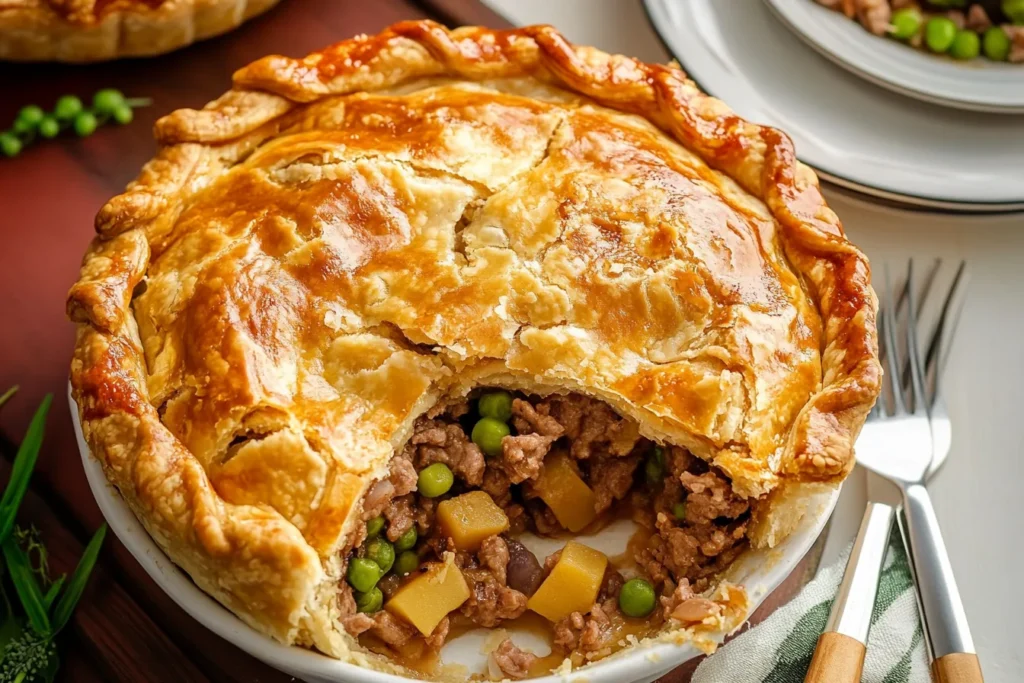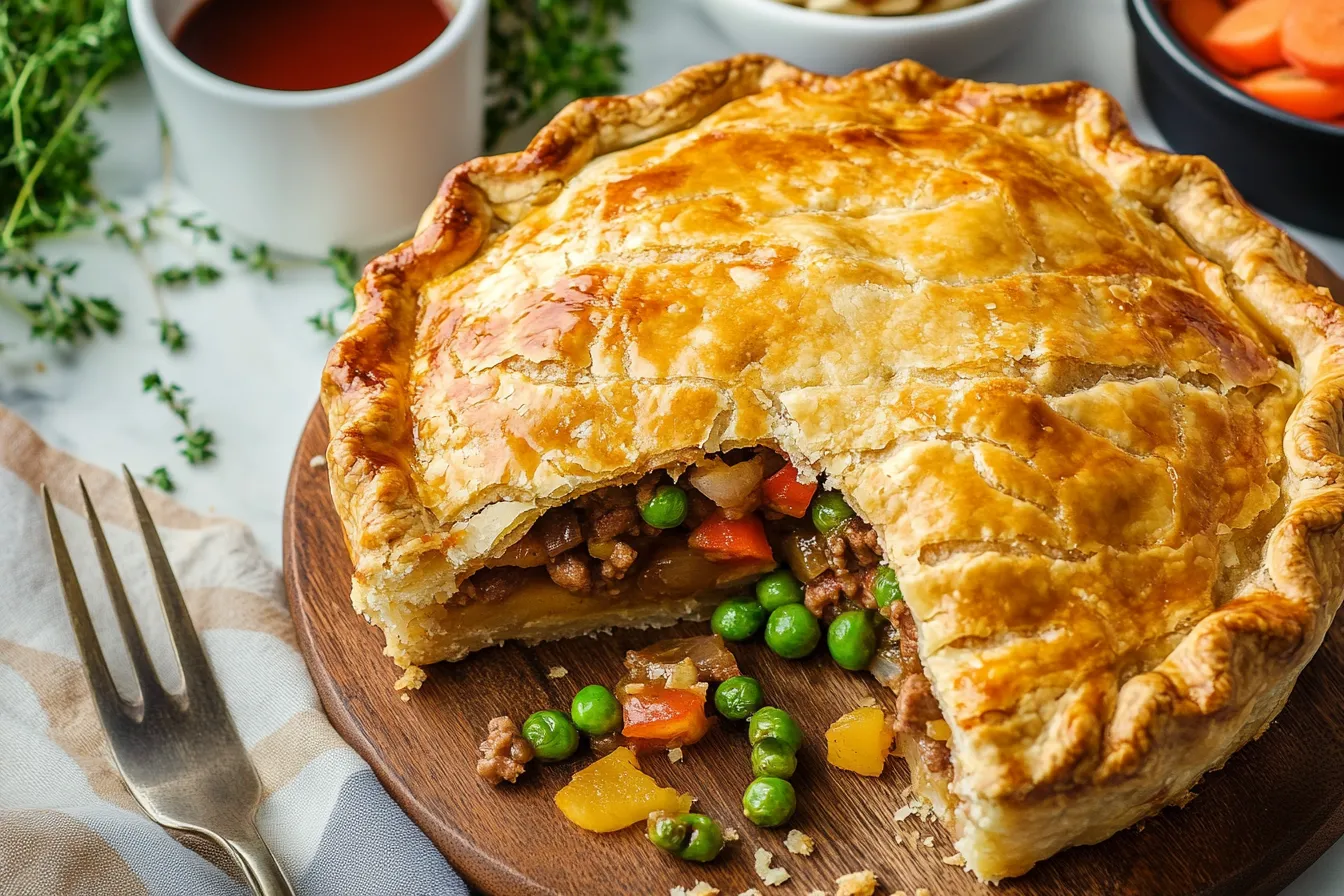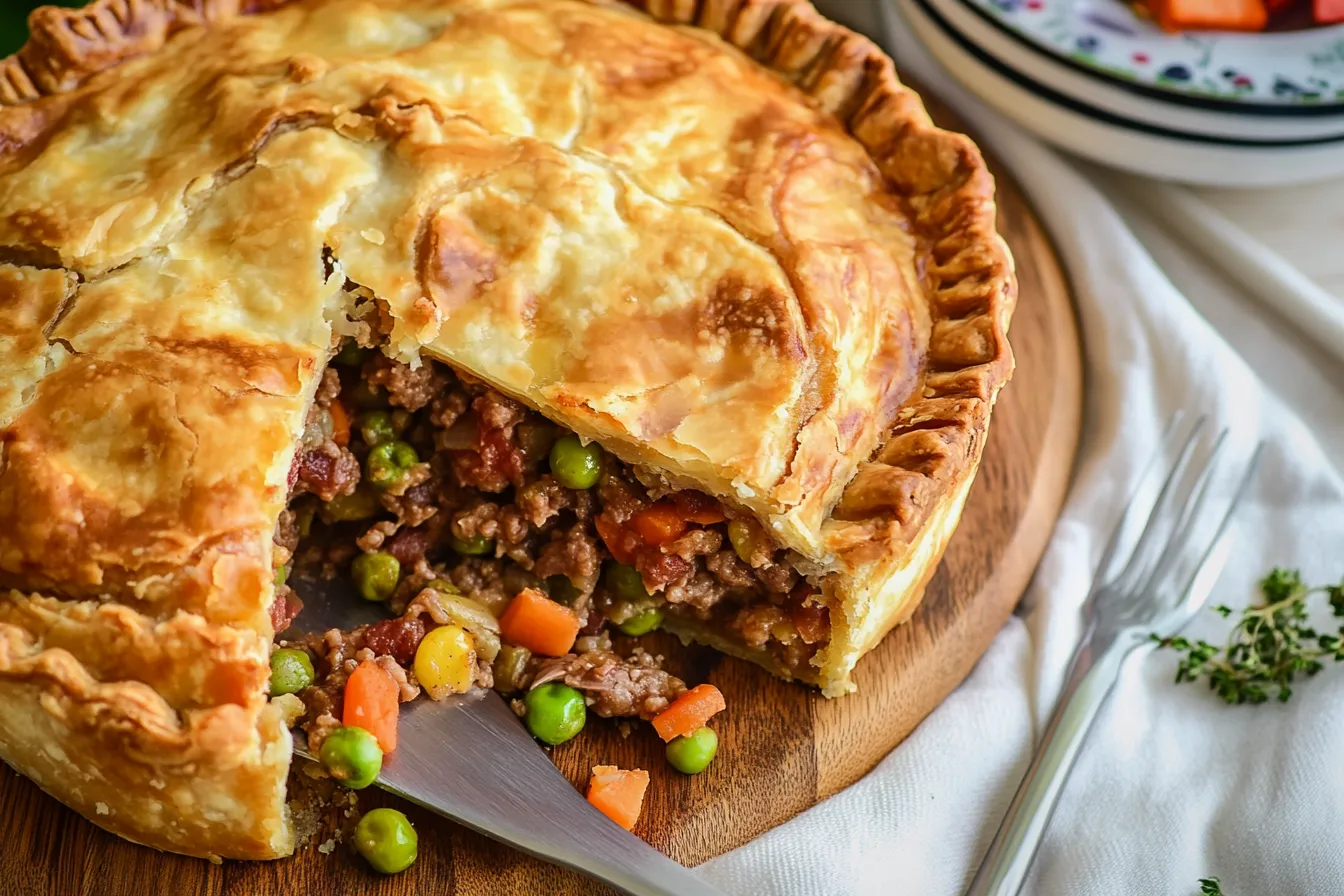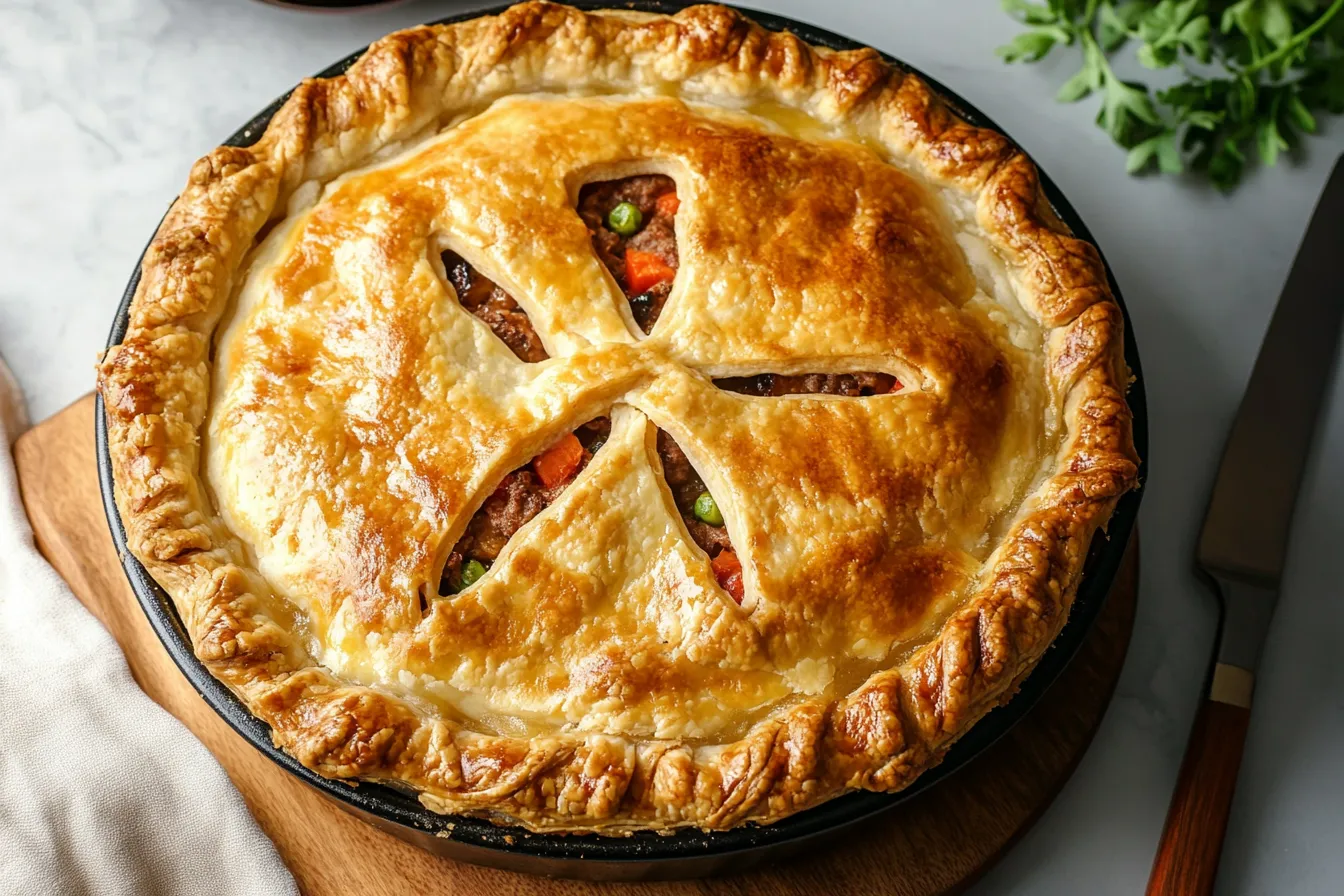Meat pies have a thick, flaky crust. Inside, you’ll find a mix of meat, spices, and herbs. On the other hand, pot pies have a soft, biscuit-like crust. They’re filled with a thick stew of vegetables, meat, and savory sauce.
The way these pies are cooked also differs. Meat-pies are baked until they’re golden. Pot pies can be baked or simmered on the stovetop. This ensures the filling is tender and the crust is flaky.
Key Takeaways
- Meat-pies have a thick crust with seasoned meat inside. Pot pies have a soft crust over a stew-like filling.
- Meat-pies are baked until golden. Pot pies can be baked or simmered on the stovetop.
- Both pies have deep roots in different cultures. They hold special places in many culinary traditions.
- Knowing the differences helps us appreciate each pie’s unique qualities. It’s key to enjoying baked comfort foods.
- Mastering the crust and filling is crucial for both meat-pies and pot pies.
Introduction to Traditional Pie Categories
Pies are a favorite in many cultures, offering both savory and sweet treats. They delight our taste buds and show us the rich regional variations and culinary history of different places.
Pies fall into two main types: savory and sweet. Savory pies are filled with meats, veggies, and spices. Sweet pies have fruit, custards, or other sweet fillings.
| Savory Pies | Sweet Pies |
|---|---|
| Meat pies, pot pies, empanadas, spanakopita | Apple pie, pecan pie, pumpkin pie, key lime pie |
| Typically feature a flaky or buttery crust | Often have a more delicate or crumbly crust |
| Filling is usually hearty and rich in flavor | Filling is usually sweet and fruit-based |
There are many regional pies and traditional recipes. They show the diverse culinary heritage of cultures. From British meat-pies to American pot pies, pies take us on a tasty journey through time and place.
“Pies are not just a dessert; they are a way of life, a celebration of the seasons, and a testament to the ingenuity of home cooks everywhere.”
What is the difference between a meat pie and a pot pie
Meat-pies and pot pies are both savory treats, but they’re not the same. Knowing the differences can help you pick the perfect dish for a cozy meal.
Crust Variations
Meat-pies have a shortcrust pastry, which is flaky and crisp. Pot pies, however, use puff pastry. This makes them light and airy.
Filling Consistencies
Meat-pies have a thick, hearty filling. The meat and veggies are tender and well combined. Pot pies have a gravy-based filling. This makes them saucy and cohesive.
Serving Methods
Meat-pies are baked in individual servings. They’re easy to hold and eat on the go. Pot pies, by contrast, are baked in a dish. They’re served family-style.
Choosing between a meat-pie and a pot pie depends on your preference. Do you like a flaky crust and hearty filling? Or a light, saucy filling in puff pastry? Knowing the differences helps you make the best choice for your next meal.
Origins and Cultural Significance
Meat-pies and pot pies have deep roots in Britain and the United States. They have become beloved comfort foods, loved by many. These dishes have evolved over time, becoming a part of our culture.
The history of British meat-pies goes back to ancient Roman times. They were a staple for soldiers and commoners. As the British Empire grew, these pies spread worldwide, changing with local tastes. Now, we have classics like the Cornish pasty and steak and kidney pie, loved by all.
American pot pies started in the colonial era, brought by early settlers. Over time, they changed, using local ingredients. Today, the chicken pot pie is a favorite, bringing families together with its warm, comforting taste.
Both British meat-pies and American pot pies are more than food. They symbolize cultural identity, nostalgia, and the need for comfort. These traditions keep evolving, with new flavors and meanings added to these comfort foods.
“Pie is the food of the heroic. No matter what, pies are soothing, delicious, and make families break into song.”
– Sarah Orne Jewett, American author
Essential Components of a Classic Meat Pie
To make the perfect meat-pie, you need to know the key parts. This includes choosing top-notch meats, mastering traditional seasonings, and perfecting the crust. Each part is crucial for great taste and texture.
Traditional Meat Selections
The base of a meat pie is the meat. Beef, lamb, and pork are favorites, but there’s more. Venison and mixes of meats add depth and richness.
Seasoning Profiles
The seasonings make a meat-pie special. Recipes mix herbs and spices for a rich flavor. Thyme, rosemary, and bay leaves add a savory touch.
Crust Techniques
The crust is the pie’s crown. Making it flaky and tender is an art. It’s all about chilling, mixing, and rolling right. The result is a golden shell that complements the filling.
“The true test of a meat-pie’s quality lies in the seamless integration of its essential components – the meat, the seasonings, and the crust. Get these elements right, and you’ll have a dish that’s truly worthy of being called a classic.”
Mastering these elements lets you create a meat-pie that honors tradition. It’s a culinary journey that celebrates regional and cultural heritage.
Anatomy of an Authentic Pot Pie
The chicken pot pie is all about layers of flavors and textures. At its core is a mix of tender chicken, vegetables, and a creamy velvety sauce. This filling is wrapped in a flaky, golden puff pastry top, making it both comforting and beautiful to look at.
The chicken in a classic pot pie is shredded or cubed for tenderness. It’s mixed with diced carrots, peas, potatoes, and onions for a burst of color and taste. The creamy sauce holds it all together, made with a roux-based gravy, milk or cream, and herbs and spices for flavor.
The puff pastry crust is the pot pie’s crowning glory. It’s light and airy, turning golden brown when baked. This crust seals in the flavors and adds a stunning look to the dish.
| Ingredient | Purpose |
|---|---|
| Chicken | Provides the main protein and tender texture |
| Vegetables (carrots, peas, potatoes, onions) | Add color, flavor, and nutritional value to the filling |
| Creamy sauce | Binds the ingredients together and creates a velvety, cohesive filling |
| Puff pastry | Delivers a flaky, golden-brown crust that seals in the flavors |
The mix of chicken, vegetables, creamy sauce, and puff pastry makes the chicken pot pie special. Each bite is a perfect blend of flavors and textures, making it a beloved comfort food.
Mastering the Perfect Pot Pie Gravy
Making the perfect pot pie gravy is key to a great dish. Whether you’re a pro chef or a home cook, learning to thicken, season, and avoid watery gravy is crucial. It can transform your pot pie into a masterpiece.
Proper Thickening Methods
The secret to a rich pot pie gravy is the right thickener. A classic roux (fat and flour mix) works well, but cornstarch is also a good choice. Slowly whisk in cornstarch and let the gravy simmer until it’s just right.
Seasoning Balance
Getting the seasoning just right is vital for a flavorful pot pie gravy. Try different herbs and spices like thyme, rosemary, or sage. Mix them well to create a taste that complements the filling. Keep tasting and adjusting until it’s perfect.
Preventing Wateriness
Got a watery pot pie filling? The solution is in the thickening and the quality of your ingredients. Make sure your veggies are drained well. You might also need to use less liquid or more thickener to get the right consistency.
Mastering pot pie gravy will make your dish a hit with everyone. Don’t be afraid to try new techniques and flavors. Find the recipe that makes your taste buds dance with joy.
Crust Troubleshooting: Preventing Sogginess
Getting a crisp and flaky crust is key for both meat and pot pies. But, it can be tricky. A soggy crust can make your dish less enjoyable. Luckily, there are ways to keep your crust golden and crunchy.
Blind baking is a great method. It means baking the crust before adding the filling. This creates a barrier that keeps the crust dry. Just line the crust with parchment or foil, add pie weights or beans, and bake until it’s partway cooked.
Using an egg wash on the crust is another trick. It makes the crust shiny and seals it, keeping moisture out. Mix an egg with a tablespoon of water, then brush it on the crust before baking.
If your crust is still soggy, try less liquid in your filling. Too much liquid can make the crust soggy. So, thicken your sauces and gravies well.
So, blind baking, egg washes, and adjusting your filling are all good tips. They help keep your pot pie crust crisp and tasty, no matter what’s inside.
“The secret to a perfect pie crust is all in the technique. Blind baking and egg washes are game-changers when it comes to preventing sogginess.”
Regional Variations and Popular Recipes
Explore the world of meat-pies and pot pies from different places. The beef pot pie recipe from America and the Cornish pasty from Britain are just the start. These dishes have been changed and loved by many cultures, showing the wide range of this tasty tradition.
American Pot Pie Styles
In the United States, chicken pot pie is a big hit. It has tender chicken, creamy sauce, and a flaky crust. But, beef pot pie is also a favorite, with its juicy beef and savory filling. These pies are great for sharing with loved ones, making any meal special.
British Meat Pie Traditions
In Britain, meat-pies are a big deal. The Cornish pasty is famous for its crimped edge. These pies, filled with meat, potatoes, and onions, are a big part of British food history.
Global Interpretations
Meat pies and pot pies are loved all over the world. In Latin America, empanadas offer a tasty twist with their flaky pastry and fillings. The Middle East and India have their own versions, like sfiha and samosa, showing how this dish can be enjoyed in many ways.
These different meat-pies and pot pies are loved by people everywhere. They give us a peek into the rich world of food traditions.
Essential Equipment and Baking Techniques
Making the perfect meat-pie or pot pie needs the right tools and baking skills. You’ll need pie dishes and ramekins for the job. Also, knowing the best baking temperatures and how to use steam vents is key.
Choosing the right bakeware is important for texture and look. Pie dishes come in many materials, sizes, and shapes. Ramekins are great for serving one or testing recipes.
Keeping the right baking temperatures is crucial. It makes the crust golden and the filling perfect. Try different oven settings to get the flaky, crisp crust you want.
Don’t forget about steam vents. They let out extra moisture. This keeps the pie crust from getting soggy and keeps the pie intact.
| Equipment | Recommended Features |
|---|---|
| Pie Dishes | Glass, ceramic, or metal construction; various sizes and shapes |
| Ramekins | Porcelain or ceramic material; single-serving portions |
| Oven Temperatures | 350°F to 425°F for optimal crust and filling doneness |
| Steam Vents | Properly placed openings in the top crust to release excess moisture |
Learning about the basics of equipment and baking will help you make amazing pies. Your family and friends will love them.
Tips for Freezing and Reheating
Keeping your homemade meat-pies and pot pies fresh is key. The right storage and reheating can make a big difference. Follow these tips to enjoy your tasty pies even after they’re baked.
Storage Best Practices
Store your pies in freezer-safe containers or heavy-duty resealable bags. Make sure there’s enough space for the pie to expand when it freezes. Sealed properly, your pies can stay fresh in the freezer for up to 3 months.
Reheating Methods
When it’s time to enjoy your pie, you have a few ways to do it. Thaw the pie in the fridge overnight and then reheat it in a preheated oven at 375°F. This way, the filling will be hot and the crust golden brown.
If you’re in a rush, you can reheat the pie straight from the freezer. Just add 10-15 minutes to the baking time.
Make-Ahead Solutions
Make your pie fillings and crusts ahead of time. Then, assemble and freeze the unbaked pies for easy meals. When you’re ready, just bake the frozen pie in the oven, adjusting the time as needed.
This method lets you have freshly baked pies whenever you want. It’s easy and saves you from starting from scratch every time.
FAQ
How do I make my pot pie crust not soggy?
To avoid a soggy pot pie crust, follow these steps: – Blind bake the bottom crust first. This helps it stay crisp. – Use an egg wash on the crust to block moisture. – Make sure to vent the top crust to let steam out. – Don’t overfill the pie, as too much liquid can make the crust soggy.
Why is my pot pie so watery?
Watery pot pie filling often comes from: – Too many high-water content veggies. – Not thickening the sauce enough. – Overcooking the filling before assembling. – Not sealing the crust edges well, letting steam escape. To fix it, thicken the sauce with a roux or cornstarch. Also, make sure the crust is well-sealed.
What is pot pie gravy made of?
Pot pie gravy is made from: – A roux of butter and flour. – Whisking in broth, like chicken or beef, slowly. – Simmering until it thickens. – Seasoning with herbs, spices, and sometimes cream or milk.
What is a beef pot pie recipe?
Here’s a simple beef pot pie recipe: Ingredients: – Pie crust (top and bottom) – 1 lb ground beef – 1 onion, diced – 2 carrots, diced – 2 potatoes, diced – 2 cups beef broth – 2 tbsp flour – Salt and pepper to taste Instructions: 1. Cook the ground beef and onion in a skillet until browned. 2. Add the carrots and potatoes, and cook for 5 minutes. 3. Stir in the flour and cook for 1 minute. 4. Slowly add the beef broth, stirring constantly, until thickened. 5. Season with salt and pepper. 6. Pour the filling into a pie dish and cover with the pie crust. 7. Bake at 375°F for 30-40 minutes until the crust is golden.




